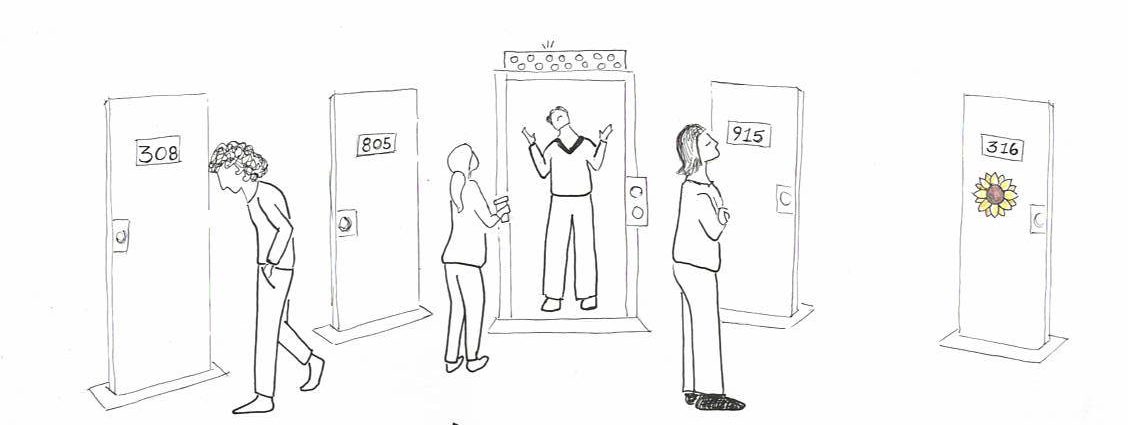What scripts look like and how we use them
TSDC scripts do not look like conventional literary play scripts. As we discussed above, the first way we present the play’s ‘script’ to performers is as a kind of scene map.
Here’s an excerpt from a When My Home is Your Business scene map:
S2. Everyone frustrated the elevator doesn’t work.
SAMI pushes buttons but elevator doesn’t go where he wants, elevator is crazy, computer chip doesn’t work
EMMA waits for elevator
ALICE comes out of apartment, EMMA turns her back on Alice, ALICE returns quickly to apartment
HANNAH waits for elevator, why does she always have to wait so long, they’re always using one of them for the construction…

Once we’re pretty clear on what the scenes will look like in the performance, we review video documentation of the individual improvised scenes and write a skeleton script (see sample below) that includes key dialogue and stage directions for each scene. Looking over the documentation gives us a chance to consider how dialogue and action could be tightened up to maintain a strong flow of action while keeping the audience’s focus where we want it. This is not something that’s easy to do when improvising scenes, since the point of improvising is for performers to feel free to explore.
We also try to capture those moments from improvising when performer-advocates had particularly good ways of expressing something that make the situation clearer and provide audiences with the context they need to understand it in the way the performers intend. For instance, at one point in We Need to Talk!, a performer pointed out the serious consequences of inaccurate information being recorded in social welfare files. At a crucial moment in an improvisation of the scene when she was asking why her benefits had been cut off, she said: “No. I don’t OWN a Chrysler, I used to WORK at Chrysler!” Because the line captured the problem quickly and clearly, we wanted to remember to use it, so included it in the dialogue of the skeleton script.
Once we’ve established a pattern of action and speech, we write up the skeleton script. This is helpful for rehearsals, even though performers are not expected to say their dialogue exactly as it is written.
A skeleton script with ‘just enough’ written-out dialogue and stage directions:
- Helps performers remember what they wanted to say in each scene without having to reinvent it every time they go onstage.
- Establishes verbal cues that are prompts for action.
- Helps performers remember particularly well-phrased expressions from prior improvisations of a scene.
- Allows another performer, or a member of the artistic team, to replace a performer who is unable to go on stage at a scheduled performance due to illness or other personal issues.
The scene map during the performance
“Having the scene template on the door so we have an idea of what’s gonna happen, like anchors of who is going to be there. That really calmed me down.” — Performer-advocate, When My Home is Your Business.
A revised final ‘scene map’ is also used as a reminder of the order of scenes and what happens in each of them during the final performance. These are strategically located on the set in places where they aren’t visible to the audience but participants will be able to read them (like the back of the doors in When My Home Is Your Business, or on the documents that characters from We Need To Talk! carried from agency to agency).
Sample skeleton script scene with dialogue and stage directions: When My Home is Your Business
2. Everyone frustrated the elevator doesn’t work.
SAMI leaves apartment and goes to Elevator. He pushes the button and then gets in.
SAMI : What is happening with this elevator. I pressed lobby and we’re going up!
EMMA leaves her apartment and stands in front of the elevator to wait for it.
SAMI: So now we are going down to the parking garage!! No, no. I want to go to the lobby!
ALICE comes out of her apartment and moves towards the elevator. EMMA sees Alice and turns her back on her. ALICE is embarrassed about what happened last night and doesn’t want to talk about it, so she goes back to her apartment to wait for Emma to get on the elevator and leave.
SAMI: This elevator is just crazy! When I want to go down it goes up, when I want it to go up it goes down. There is something seriously wrong with the computer chip that runs this thing!
3. Explaining What Happened on Emma’s Floor Last Night
Elevator arrives and EMMA gets on.
EMMA (to Sami): Good morning.
SAMI: Good morning. It was very noisy on your floor last night.
EMMA: Yes. That Alice and the man who visits her. When they get to drinking they always end up in the hallways yelling and screaming at each other. She needs help.
HANNAH: (checking her watch) How long will I wait this time? It’s always like this. It’s so slow. It’s so inefficient. I cannot believe they cannot coordinate these elevators the way they should. There’s always one “in service” for the construction!
HANNAH gets on the elevator. Everyone greets each other.
ALICE: (on the phone with her brother). Well I hope you’re happy. You come in here drunk, crashing into the walls all the way down the hall and banging on my door in the middle of the night. You woke up all the neighbours and now they won’t even speak to me. Don’t you ever embarrass me like that again! I don’t care what Mom said to you! No, there’s nothing to talk about it. Don’t show up here drunk again! (She slams down the phone and sits heavily on her chair, head in hands.)

